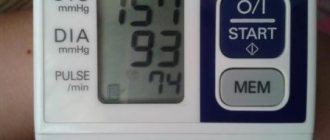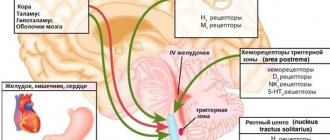Provoking factors
Factors that provoke nausea and weakness include any irritants that cause pressure surges in the patient, which causes an exacerbation of the pathology. In addition, the cause of increased blood pressure resulting in nausea may be recent severe stress, a change in climate zone, flight, etc.
Many people are wondering at what pressure nausea occurs.
https://youtu.be/6IM3Ot6QgSM
Changes in weather conditions
Changes in weather conditions are fraught with deterioration in the well-being of people suffering from weather dependence. When barometric pressure changes, they may develop hypertension (more often than hypotension), which is accompanied by nausea. Smokers, as well as people who drink alcohol, have a certain risk of increasing or decreasing blood pressure. Nicotine promotes contractility of the vascular wall, as a result of which the vessels quickly wear out and become flabby. This contributes to the fact that in such people, under the influence of external factors, the vascular system cannot cope with its functions, and malfunctions occur in its functioning. This causes a violation of blood pressure, resulting in severe nausea.
Why do nausea occur?
Blood pressure surges do not occur without a reason. Doctors conditionally divide these factors into three main blocks:
- Prolonged overload of the body. Many people mercilessly exploit their body, not allowing it to fully recover, do not follow a work-rest schedule, and do not get enough sleep for significant periods of time. In addition, the constant stress that abounds in the life of a modern person also has a detrimental effect on health. Under such conditions, the body’s cardiovascular system reacts with malfunctions and surges in blood pressure.
- Bad habits. People who do not lead a healthy lifestyle are especially susceptible to changes in blood pressure. Alcohol, drugs, stimulants, smoking, excess weight, overeating, physical inactivity - everything that destroys health also causes problems with normal blood circulation.
- Weather conditions, their sudden changes, increase or decrease in atmospheric pressure. This is another factor that, unlike the previous ones, a person cannot influence.
As the body naturally ages and chronic illnesses develop, a person becomes more and more susceptible to changes in atmospheric pressure and sudden changes in air temperature.
The body reacts violently with hypertensive attacks, releases adrenaline into the blood, the pulse quickens, and panic attacks are possible. The tension of the sympathetic nervous system increases many times over, which provokes a gag reflex.
These unpleasant sensations indicate problems with blood circulation in the brain. Swelling forms on the cerebral cortex, which, due to spasm, puts pressure on the vomiting center.
Even with hypotension, a person may experience chills, increased sweating, gagging and pain in the temporal lobes.
Therefore, it is necessary to immediately find out why the head may feel dizzy and hurt, for what reason the patient feels sick, and at what pressure the headache occurs.
Similar symptoms of jumps in blood pressure, both downward and upward, as well as nausea in other diseases (for example, poisoning) can be misleading, taking away valuable time.
The time factor is especially significant with high blood pressure. Timely assistance can prevent a stroke and its irreversible consequences. For correct and timely treatment, it is necessary to determine at what pressure level a person feels sick.
A sharp rise in blood pressure disrupts brain function. Swelling of the tissue causes throbbing pain in the back of the head, severe dizziness, bordering on fainting.
If you feel sick and vomit with high blood pressure, this often means that the hypothalamus, the organ responsible for brain stability, is damaged.
The hypothalamus is involved in regulating the functioning of many systems of the human body, participates in the production of important hormones, affects thermoregulation, a sense of satiety, and emotions.
If such a delicate mechanism that maintains the balance of all body systems fails, the entire body is deprived of balance.
The answer to the question of why a patient feels sick with high blood pressure lies in the mechanism of the cardiovascular system.
An increase in pressure increases the heart rate, the volume of blood flow that the vessels cannot cope with, and the risk of blood flowing back into the heart develops.
To prevent this, the body must get rid of excess fluid. This is why patients with high blood pressure experience increased sweating, frequent urination, and vomiting.
Typically, in an adult, hypertension manifests itself with certain symptoms, including:
- spasmodic headache, concentrated in one half of the head, accompanied by nausea and vomiting;
- a sharp decrease in vision with the appearance of spots before the eyes;
- redness of certain areas of the skin;
- increased heart rate, which makes breathing faster;
- noise in ears.
It is not necessary to have all these symptoms at the same time - even one or two signs warn of adverse changes in the body caused by hypertension with frequently recurring high blood pressure.
Nausea and vomiting can occur not only with high but also with low blood pressure. Can diametrically opposed causes provoke the same consequences? Can you feel sick at high and low blood pressure levels?
Yes, the symptoms of low and high blood pressure are similar, although they have different prerequisites.
Low blood pressure, in addition to nausea, is accompanied by:
- severe headache (usually on one side of the head);
- dizziness;
- when there is a sudden change in a person’s position, there is a blurred vision before the eyes.
This can happen when the upper pressure reading on the tonometer in an adult is less than 100 mmHg. Art.
A decrease in blood pressure occurs against the background of mental or mental stress, endocrine system disorders.
When you feel sick with high blood pressure, there is a risk of developing an attack of hypotension (if you take an excessive dose of medications designed to lower blood pressure).
It is not only high and low blood pressure that increase dizziness and provoke nausea.
If blood pressure is normal, and the patient experiences attacks of nausea and vomiting, this may be a symptom of various diseases:
- osteochondrosis;
- diabetes mellitus;
- depression;
- neurological disorder;
- neurosis;
- disorders of the vestibular apparatus;
- inflammation of the middle ear;
- digestive disorders;
- poisoning
If the tonometer detects a normal blood pressure level with symptoms similar to those of high or low blood pressure, you should consult a doctor to determine what exactly is making you feel worse.
Self-administration of drugs that increase blood pressure, or anti-nausea drugs that affect the vomiting center of the brain, can lead to undesirable results and blur the clinical picture. This will make it difficult to make a correct diagnosis.
Nausea with low blood pressure
A similar symptom of low blood pressure can occur for various reasons. It is important to determine the cause of this pathology and eliminate it. When blood pressure drops, the patient may experience not only nausea, severe headaches, vomiting, fainting, and poor coordination of movements. Such pathological conditions are caused mainly by the following factors:
- Exhaustion of the body, which is caused by forced or forced fasting.
- Nausea with pressure can be caused by the development of internal bleeding.
- Pathologies of internal organs (kidneys, adrenal glands, liver, pancreas, stomach, intestines).
- Physical or nervous stress.
- Chronic stress, disruption of daily routine, lack of sleep.
When pressure drops, many people do not experience discomfort and learn about such disorders only after a medical examination.
Weakness, dizziness, nausea and low blood pressure are the result of a person getting motion sickness in a car. When it is possible to eliminate the irritating factor and remain at rest for some time, the condition will return to normal. However, it often happens that the patient does not get better, then you should call an ambulance and give him first aid.
What other types of nausea can occur with blood pressure?
Can blood pressure make you sick?
People with unstable blood pressure (BP) often complain of feeling unwell.
Nausea most often occurs when blood pressure is higher or lower than normal. This symptom does not appear immediately, but after the development of the pathology. Getting rid of nausea is difficult, since conventional medications do not always help stabilize the condition. It is recommended to familiarize yourself in advance with the main causes of nausea with impaired blood pressure and consider the most effective treatment methods. Not all people know whether vomiting can occur due to high or low blood pressure. It definitely can, since with sudden jumps in blood pressure in the spinal cord and brain, all processes associated with blood circulation are disrupted. This leads to the fact that the vomiting department, located in the brain stem, is irritated, and severe nausea occurs. If the pressure increases very strongly, then in addition to this symptom, others develop - ringing in the ears, headache and dizziness.
Most often, vomiting occurs in people who have suffered from hypertension for several years. However, hypotensive patients also experience this symptom. If low blood pressure is not normalized in a timely manner, a person may experience fainting, weakness, and problems with the gastrointestinal tract. If the above symptoms occur, it is better to visit a doctor to determine your blood pressure level and prescribe effective treatment.
When does nausea occur? This symptom can occur with both high and low blood pressure. It is recommended to familiarize yourself with the features of the appearance of vomiting at different blood pressure levels.
Vomiting often appears as a complication of hypertension. It occurs against the background of impaired blood circulation in the brain tissue and irritation of the vomiting department.
However, some experts also name other causes of nausea with high blood pressure. A sharp deterioration in blood circulation provokes the accumulation in the body of a component such as adrenaline. Due to large amounts of this substance, people develop anxiety, fear and panic attacks. Over time, because of this, in patients with hypertension, the tone in the nervous system increases and nausea appears, accompanied by vomiting.
Vomiting is rare in patients with hypotension. It appears due to exhaustion, fatigue or general weakness of the body, which is caused by low blood pressure. To quickly get rid of nausea and other manifestations of hypotension, you must immediately raise your blood pressure. To do this, you should use vasodilator drugs that can quickly improve blood circulation.
In order to promptly determine the presence of complications caused by unstable blood pressure, it is necessary to become familiar with the first signs of nausea and its accompanying symptoms.
Children, like adults, are often subject to sudden changes in blood pressure, which can make them feel worse. Children's bodies are much weaker than those of adults, and therefore they tolerate hypotension or hypertension less well. With such diseases, in some children, the central and peripheral parts of the vestibular apparatus are affected, which leads to nausea. This symptom is accompanied by a number of other signs, which include:
- vomiting;
- increased sweat production;
- general weakness;
- hearing problems.
If your baby exhibits the above symptoms, you should immediately visit a doctor.
Adults feel nauseous due to frequent fluctuations in blood pressure during the day. This leads to poor balance, poor hearing and dark circles under the eyes. However, there are other symptoms that appear in people under 50:
- dizziness;
- sense of anxiety;
- depression;
- weakness;
- apathy;
- panic attacks;
- stomach ache.
In addition to the symptoms described, some patients begin to experience severe headaches. In this case, it is better to immediately take painkillers.
In elderly people, nausea and vomiting with high blood pressure is difficult to tolerate. In addition to gagging, patients experience the following symptoms:
- lethargy;
- impaired coordination of movements;
- headache, in which the headache is worse in the evening than in the morning;
- blurred vision.
It is recommended to understand in advance why vomiting occurs in people with unstable blood pressure. This will help you get rid of this unpleasant symptom faster. To identify the exact cause of nausea due to arterial hypertension, you should undergo a full medical examination, which includes regular blood pressure measurements and additional laboratory tests.
If vomiting during a hypertensive attack is accompanied by an unsteady gait, dizziness and weakness in the limbs, then this indicates chronic fatigue. In this case, the patient needs a good rest, which will help relieve fatigue more quickly. However, there are more serious diseases that provoke nausea with an increase in blood pressure:
- impaired blood circulation in brain tissue;
- heart diseases;
- inflammatory processes in the body;
- impaired functioning of the nervous system;
- diabetes.
The most serious factor provoking vomiting during blood pressure surges is considered to be cardiovascular diseases. They provoke the development of serious complications that significantly complicate the treatment of pathology in the future.
If nausea with severe vomiting suddenly appears, you must call an ambulance so that doctors can quickly restore normal well-being. However, before their arrival, you will have to take measures to reduce nausea.
It is recommended to use special relaxation techniques. They will help you calm down and take your mind off the feeling of discomfort. Relaxation methods include the following:
- Autogenic relaxation. The most common and effective is the autogenic technique, which is aimed at diverting attention from nausea. When performing the exercise, you need to completely relax the muscles of the body, breathe deeply and think about something peaceful. To reduce unpleasant nausea, you need to carry out the procedure for at least ten minutes.
- Visualization. This method helps people with a good imagination. When using visualization techniques, the patient must relax, imagine a calm place and completely immerse himself in it. The procedure is performed in a sitting position with eyes closed.
Some people do not know what to do to quickly get rid of nausea caused by pressure surges. Experts advise hypertensive patients to change their diet to prevent vomiting. However, this is not enough to get rid of such an unpleasant symptom.
Drug treatment is aimed at stabilizing blood pressure in patients. To do this, it is recommended to use a product such as Cordiamine. Before starting treatment with this drug, you need to familiarize yourself with its contraindications. It should not be used by girls at any stage of pregnancy, epileptics and children under ten years of age. Everyone else can take 20-25 drops of the medicine daily.
Citramon, which dilates blood vessels and improves blood circulation, can also normalize blood pressure. For five days you need to take one tablet per day. If your health has not improved during this time, you will have to take the medications for 2-3 days longer.
To lower high blood pressure, doctors advise periodically performing acupressure massage.
First, the area located 4-5 cm below the kneecap is massaged. Here the skin is gently massaged with your thumb for about 5-10 minutes. The procedure is then carried out around the metatarsal bones and the inside of the ankle. The massage is carried out carefully, without strong pressure with your fingers. For people who have never done massage before, it is better to contact a specialist who will do this work better.
Traditional medicine helps to quickly get rid of all the symptoms of high and low blood pressure. Effective traditional medicines include:
- Garlic with milk. A mixture prepared from these products helps to quickly get rid of the signs of high blood pressure. To prepare the medicine, add two heads of grated garlic to 300 ml of milk. All ingredients are mixed, after which the mixture is drunk twice a day.
- Ginger. A healthy tea is prepared from the root of the plant, which can normalize blood pressure. To prepare a medicinal mixture, add ginger root to half a liter of warm water and infuse the liquid for two hours.
To prevent nausea during blood pressure surges, it is recommended that you familiarize yourself with the rules for preventing pathology. To do this, you should adhere to the following recommendations:
- Stop smoking. Regular smoking negatively affects the stability of blood pressure and therefore you should give up tobacco products.
- Proper nutrition. Often, due to an incorrectly formulated diet, symptoms of hypotension or hypertension develop. It is necessary to eat in such a way that the body mass index does not exceed 20 kg/m2.
- Refusal of alcohol. Alcoholic drinks negatively affect the condition of blood vessels and therefore it is better to avoid drinking them.
Many people complain of problems with blood pressure, which are accompanied by unpleasant symptoms that make them feel worse.
Common signs of pathology include nausea and vomiting. To get rid of it, you should familiarize yourself with the features of normalizing blood pressure using various methods.
Nausea with high blood pressure is a serious symptom and requires immediate medical attention. These may be the first signals of increased intracranial pressure or stroke. The development of the disease can be prevented if you follow all the doctor’s recommendations and lead a healthy lifestyle.
Hypertension occurs not only in older people, but also in young people; sometimes blood pressure increases even in children. It happens that people with hypertension feel good. Regardless of how you feel, if your blood pressure rises above 140/90, you need to consult a doctor and adjust your lifestyle.
High blood pressure negatively affects all organs and systems of the body. Over time, the walls of blood vessels become deformed and become thinner, and there is a risk of strokes, heart attacks, and coronary artery disease. The kidneys, heart, and cerebral circulation centers are affected, and vision is impaired.
If the disease is not treated, a person develops tremors of the limbs, memory impairment, shortness of breath, problems with urination, and coordination of movements. Poor circulation and vascular spasms lead to sclerotic formations and the proliferation of connective tissue to the detriment of the tissues of healthy organs.
With high blood pressure
The main symptoms of high blood pressure are dizziness, nausea and vomiting.
Nausea with hypertension is usually provoked by a change in normal blood circulation in the brain. As a result of this, irritation of the vomiting centers occurs, which is the main reason that provokes this symptom. In addition to disrupting brain activity, high blood pressure causes a person to have an attack of fear and panic, which, in turn, provokes the release of adrenaline into the blood. As a result, changes occur in the functioning of the sympathetic nervous system, its tone rises, the patient feels nausea with pressure, and if such tension cannot be eliminated, he vomits.
Prevention
In people suffering from hypertension, attacks of nausea and vomiting occur due to deterioration of cerebral circulation. In addition, poor health occurs due to microdisturbances in the brain stem.
At the moment when a person’s blood pressure rises, the level of adrenaline also rises. Along with the problems described above, the patient may experience panic attacks and diarrhea.
As a preventive measure for high blood pressure, in order to reduce and normalize it, you need to do therapeutic exercises, take walks outside, reduce the time you spend watching television and reading news blocks at the computer.
It is advisable to give up bad habits, not to abuse alcohol and smoking. And also replace coffee, sugar, various types of smoked meats and fatty foods in your diet with healthier foods containing large amounts of vitamins and microelements.
Diarrhea and vomiting are signs of a variety of ailments. These unpleasant symptoms cause significant harm to health, causing a disruption in the water-salt balance.
The main provocateur of such troubles as diarrhea and vomiting is most often poisoning from stale food or an intestinal infection.
If the cause of poor health is associated with poisoning, then in order for diarrhea and vomiting to stop, you must refuse food for at least 8 hours.
Do not snack, but drink plenty of fluids. Mineral water, compote and unsweetened jelly are perfect. Drink one tablespoon every 10 minutes.
Nausea at normal blood pressure
Attacks of nausea may not always be triggered by hypertension or hypotension. Normal blood pressure is characteristic of vegetative-vascular dystonia, when vascular spasm occurs, which results in disruption of the body’s autonomic system. The main symptom is nausea. In addition, the patient often experiences severe bowel dysfunction in the form of diarrhea, shortness of breath, even fainting, and a panic attack.
The causes of dizziness and nausea with normal blood pressure are unclear to many.
Other pathological signs
In such cases, the pressure is often within normal limits, but the following pathological signs develop:
- disorientation in space;
- general deterioration of health;
- hallucinations;
- fainting;
- hearing and vision impairment.
Nausea and systematic headaches with normal blood pressure are very alarming signs that indicate that you need to see a doctor.
The causes of dizziness and nausea at normal blood pressure must be identified.
Probability of dangerous diseases
If, with normal blood pressure, persistent headache and nausea are observed, this may indicate the development of some very dangerous diseases, such as diabetes mellitus, osteochondrosis, malignant tumor processes, neurological pathologies, and problems in the functioning of the vestibular apparatus.
If the patient's blood pressure is normal, nausea can be caused by true, false, non-systemic or systemic dizziness, which manifests itself as a result of dysfunction of certain parts of the vestibular apparatus. To find out the causes of this pathological condition, you should visit a neurologist.
Other symptoms
Nausea and weakness with changes in blood pressure can be an independent symptom, or may be accompanied by some other manifestations that can help determine the cause of the underlying pathology.
With high blood pressure, such symptoms include:
- severe headache in the temporal regions;
- dizziness;
- redness of the skin;
- decreased vision and hearing;
- belching, digestive disorders;
- labored breathing.
With low blood pressure, in addition to nausea, the following may occur:
- severe headache in the occipital region;
- change in coordination;
- pale skin;
- numbness of the limbs;
- hearing and vision impairment;
- chills;
- respiratory impairment;
- severe weakness;
- fainting state.
What to do if you feel nauseous but not vomiting?
Additional symptoms
When vomiting is caused by high blood pressure, it is accompanied by high fever and diarrhea. There is also a strong heartbeat, and sometimes chest pain.
- state of lethargy;
- facial redness;
- numbness of hands and feet;
- headache.
A thorough examination is necessary to understand the causes of such an unpleasant and dangerous condition. And also do everything possible to get rid of these symptoms.
How to eliminate nausea when pressure changes
The question of how to get rid of such a symptom should be decided by a specialist. To do this, it is necessary to carry out appropriate diagnosis of concomitant diseases that can cause an increase or decrease in pressure. However, in some cases, when such a pathology does not occur systematically, but is a consequence of the influence of certain external factors, provided that blood pressure is correctly assessed, some traditional medicine or medications can be used to eliminate pressure nausea.
Treatment
When it is determined that vomiting is due to high blood pressure, first aid must be provided to prevent complications:
- take pressure readings every half hour;
- sit in a semi-sitting position to prevent suffocation; movements lead to repeated bouts of vomiting and increased blood pressure;
- take diuretics;
- If medications were previously prescribed, you must use them in the indicated dosages.
It is forbidden to try to speed up the process of stabilizing pressure, so as not to worsen the condition. You cannot use new medications on your own without your doctor’s permission.
Medicines
The main purpose of taking medications is to eliminate high blood pressure. For these purposes, antihypertensive drugs are used:
- Captopril - take ¼ or ½ tablet 3 times a day, gradually increasing the dose to 1 tablet 3 times a day, the course of treatment is individual;
- Anaprilin - take one tablet, 40 mg, 2 times a day, with the possibility of increasing the dose: 1 tablet 3 times a day or 2 tablets 2 times a day, the duration of administration is determined by the doctor.
Diuretic drugs:
- Furosemide – take a tablet a day to reduce fluid levels in the body.
Class 1 selective calcium channel blocker:
- Verapamil - take 1/6 or 1/3 tablet with meals 3 times a day, the duration of administration is determined by the doctor.
To stop attacks of vomiting, use antiemetic drugs:
- Motilak - take 2 tablets 30 minutes before meals 3-4 times a day, the duration of administration is determined by the doctor;
- Metoclopramide - take 1 tablet 30 minutes before meals with water, 3-4 times a day, course of treatment is 4-6 weeks.
Vascular spasms are relieved with medications:
- Trigan-D – take 1 tablet 2-3 times a day, for up to 5 days;
- No-spa - drink 1-2 tablets 2-3 times a day, duration of use without a doctor’s prescription is 2-3 days;
- Spazmalgon - take 1-2 tablets 2-3 times a day after meals, course of administration up to 5 days.
However, in the presence of repeated, continuous vomiting, the use of tablets is not always effective.
When the symptoms do not go away, but only intensify, you need to urgently go to the hospital or call an ambulance. The lack of timely measures and medical assistance leads to ischemic stroke.
Acupressure
To eliminate high blood pressure, acupressure is used to reduce nausea. This therapy helps eliminate headaches and stabilizes the patient’s psycho-emotional state. It takes at least 5 minutes to work on each acupuncture point to achieve results.
https://youtu.be/3bWM6gZ6hf4
Folk remedies
With high blood pressure, there is an excessive release of stress hormones, and a reduction in factors that increase nervous tension is required. To eliminate hypertension and the vomiting that occurs due to it, folk remedies are used. To relieve nausea on your own you need:
- Drink decoctions in small portions: lemon balm, mint or chamomile.
- Drink fresh green tea with the addition of grated ginger.
- Drink small sips of still mineral water.
- Grind ivy leaves and mix them with 1 tablespoon of honey. Take this remedy without drinking water.
- Grind 200 g of lingonberries, as well as 100 g of cranberries, mix, add hot water and leave for 2 hours. Take 50 ml 6 times a day.
Medication methods
In order to get rid of nausea with high blood pressure, you can take a tablet of the drug “No-Spa”, which will help relieve vascular spasms and relax smooth muscles.
If, with slightly increased blood pressure, the patient is bothered by vomiting, you can use the drug “Spazmalgon”, which acts similarly to “No-shpe”, but also relieves pain. These are antispasmodic medications that will help eliminate spasms, nausea and vomiting due to pressure. Blood pressure increases and nausea develops with severe poisoning, so the patient is advised to take diuretics, vasodilators and antihypertensive drugs.
If the headache does not stop and the patient feels sick from the pressure, you need to call an ambulance, as complications such as myocardial infarction or stroke may occur. If your blood pressure drops sharply, you can take Nootropil, Citramon, or Glycine. After this, it is recommended to lie down and wait until you feel better.
The antiemetic drug is Cerucal, but its use must also be agreed with a specialist, since this medicine has many side effects and contraindications and is used, as a rule, only in cases of acute, uncontrollable vomiting.
What else should you drink for nausea and high blood pressure?
How to help yourself
A sudden rise in blood pressure can occur when there are no close people nearby, much less specialists capable of providing first aid. In this case, doctors advise, before the ambulance team arrives, to take consistent actions that will help make you feel better:
- It is necessary to measure blood pressure using a tonometer and make sure that it is elevated, and not vice versa. This is important because hypotension can also be accompanied by vomiting, and treatment for it must be completely different.
- It is recommended to lie on the sofa with a pillow or bolster under your back.
- All physical work should be postponed, even if it gets a little better. This can only make the situation worse.
- After consultation with a specialist, you need to take a medicine that lowers blood pressure.
- If you have a severe headache, it is recommended to take one of the diuretics that was previously prescribed by a specialist after diagnosing hypertension.
- As blood pressure rises, your heart may begin to hurt. In this case, it is recommended to take Nitroglycerin.
In the process of self-treatment, it is important to remember that the pressure should be reduced very carefully so as not to provoke a deterioration in the general condition. In the future, after stabilization of blood pressure, you should visit a doctor and get recommendations for further treatment. It may be necessary to replace previously prescribed medications and adjust your lifestyle, including nutrition.
It is imperative that a patient with hypertension needs to monitor his or her well-being, live a measured, calm life, avoiding stressful situations. It is important to normalize your sleep and rest schedule, devoting at least 7-9 hours to sleep. There should be no bad habits for hypertension and its prevention.
Traditional methods of help
Any lozenges that, when sucked, make breathing easier, can help eliminate an attack of vomiting. When blood pressure drops or rises sharply, in addition to medications, you can use traditional methods. However, before using one of them, you should consult your doctor.
A recipe made from herbal ingredients helps normalize blood pressure. Take St. John's wort, chamomile, mint and lemongrass in equal proportions, chop, pour into a thermos and add hot water. The infusion is made for 3 hours, after which it should be drunk throughout the day with a spoonful of honey and lemon. By taking it for two months, you can improve the functioning of the cardiovascular system, increase the elasticity of blood vessels and normalize blood pressure.
If you feel very nauseous with high blood pressure, a slice of orange helps to eliminate the attack of vomiting, which must be put in your mouth and dissolved until the nausea subsides. Various sucking lollipops have a similar effect, which frees up breathing and helps get rid of vomiting.
It is known that approximately 30% of the adult population suffer from the problem of pressure changes, and with age the prevalence of pathology increases to 65%. The consequences of this often include irreversible damage to the heart, kidneys, brain, blood vessels, and eyes. In the later stages, coordination is impaired, weakness in the limbs occurs, vision deteriorates, memory and intelligence decrease.
What causes nausea?
The causes of high blood pressure and nausea are varied. The patient, as a rule, already long before the symptom of nausea appears, knows about the presence of the problem of high blood pressure in his body.
Drug treatment alone will not be enough. It is also important to avoid factors that provoke an increase in blood pressure in order to minimize the symptoms of the disease.
As a rule, the causes of high blood pressure and vomiting are stress, weather sensitivity, smoking and alcohol.
It is not easy to predict which of these stimuli will cause a symptom of nausea, since the sensitivity threshold is different for each person. However, by listening to your body, after some time you will understand what you should isolate yourself from in your usual lifestyle.
If nausea occurs with high blood pressure, what should you do? If the increase in pressure is accompanied by acute symptoms, then the first steps should be aimed at relieving them with the help of medications.
If nausea has not yet developed into vomiting, then sucking on mint or sour candy will help suppress this feeling. It can be replaced with a quarter of an orange, which you should not eat, but slowly extract the juice from it.
And if there is high blood pressure and vomiting, what should you do? To temporarily eliminate vascular spasm, you need to take either fast-acting blood pressure medications prescribed by your doctor or antispasmodics. This medicine will also help stop vomiting. Diuretics and vasodilators are indicated for use.
If you feel sick with high blood pressure, you must immediately stop any activity and remain calm. Don’t get nervous, as this condition also provokes vascular spasms.
If you are not sure that vomiting will not return to you, then it is better not to fall asleep. Since there is a risk of choking on vomit. The best thing to do is go to bed and rest.
In any case, this set of measures is aimed only at eliminating the symptoms of the disease and is based on its temporary suppression. With recurring symptoms such as nausea and high blood pressure, you need to undergo a thorough examination to identify the original sources of the disease. If treatment is not seriously addressed, any attack of hypertension can result in a heart attack or stroke.
Health-improving exercises, nutritional correction, therapeutic massage courses, giving up bad habits, protecting yourself from constant stress and daily walking will help to significantly reduce the symptoms of hypertension. All this has a positive effect on the functioning of the cardiovascular system, which means it helps normalize blood pressure.
You should not sharply reduce your blood pressure, as changes in blood pressure can lead to an even greater crisis.











